Darlington town centre has charm galore – so what does it need to do to really thrive?

Me against the backdrop of High Row in Darlington (25 Aug 2017)
In my job as a kind of “Geordie Mary Portas”, one of the things I most relish is the chance to visit and work with shops and retail centres all over the North East and beyond.
Out of the 500-plus towns I’ve been to, Darlington is one of my favourite places. Back in 2012, I tweeted about its “marvellous and characterful buildings and spaces” – and the area around High Row and the Clock Tower is truly one of Britain’s most magnificent bits of public realm.
I'm a big fan of Darlington – so many marvellous and characterful buildings and spaces pic.twitter.com/hFdY23cG
— Graham Soult (@soult) January 5, 2012
Sadly, I haven’t yet had the opportunity to work in Darlington, though this does mean that I can be truly objective about the strengths and weaknesses of the town centre.
Stores closing
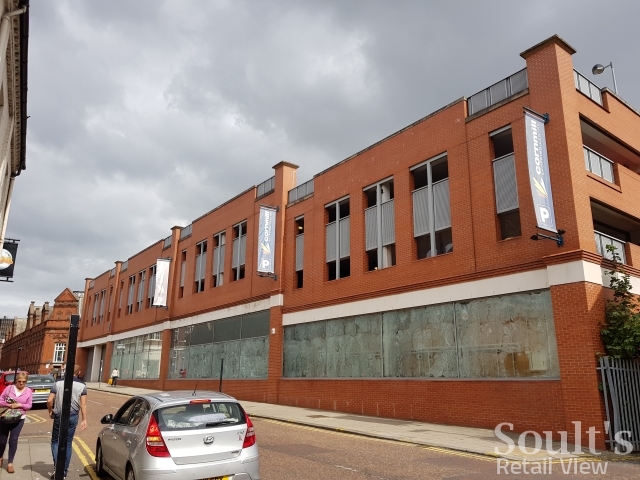
Former TK Maxx in Darlington (25 Aug 2017)
With the recent or impending departures of big names like TK Maxx, Toni&Guy and Starbucks – on top of a still stubbornly empty BHS – it’s not surprising that some people are worried about Darlington town centre’s future.
Certainly, losing popular stores is never welcome, but some churn is a natural and inevitable part of how any retail centre evolves. In some cases, such as with Argos and McDonald’s, quitting the town centre mirrors what those businesses are doing elsewhere across the UK, rather than being a Darlington-specific problem. In other cases, such as with Starbucks or Toni&Guy, the decision to close might well be related to franchise or lease issues, rather than because the business is necessarily underperforming in that location.
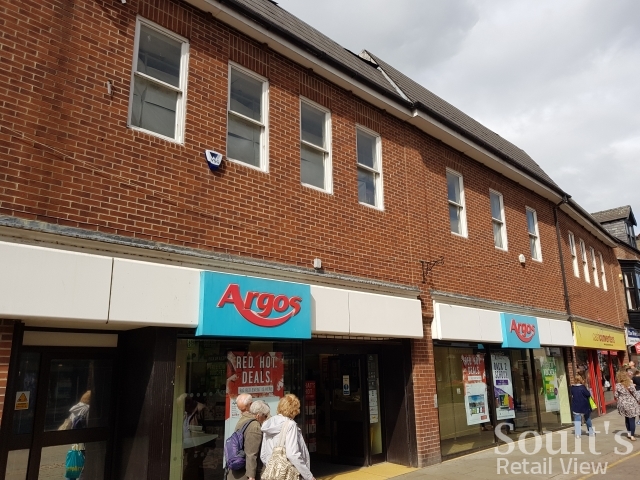
Argos in Darlington, which will shortly close (25 Aug 2017)
More often than not, new businesses pop up to fill the gaps, and it’s only when such units remain vacant in the long term – as seen for example in Bishop Auckland or Redcar – that you have real cause for concern.
Hexham, for instance, had a wobble a few years ago, when several prominent shops in the prime Fore Street pitch became vacant in quick succession, prompting a flurry of concerned headlines in the local press. However, as I predicted at the time, these units were soon refilled with new businesses that were, for the most part, more attractive than the ones they replaced.
Existing positives
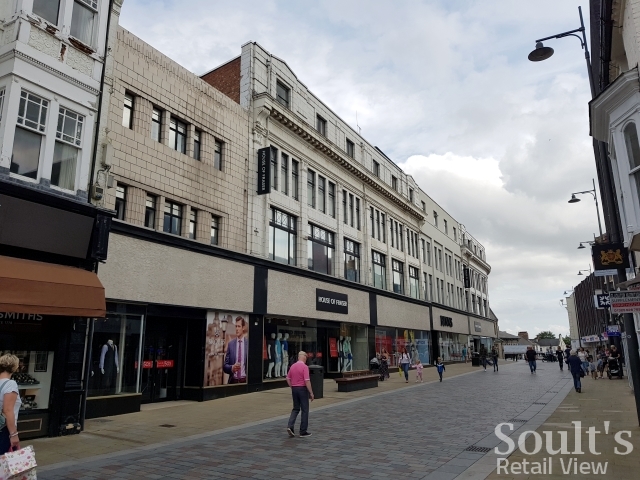
House of Fraser in Darlington (25 Aug 2017)
In this context, my overall impression is that Darlington town centre remains in pretty good shape. Looking at the town’s retail anchors, House of Fraser has recently benefited from a major makeover, which is a fantastic sign of its long-term commitment to the town.
Similarly, M&S in Northgate is sporting the retailer’s latest black-and-white fascia, which bodes well for its longevity too. Those M&S stores that still feature 1990s mint-green signage are the ones you have to most worry about.
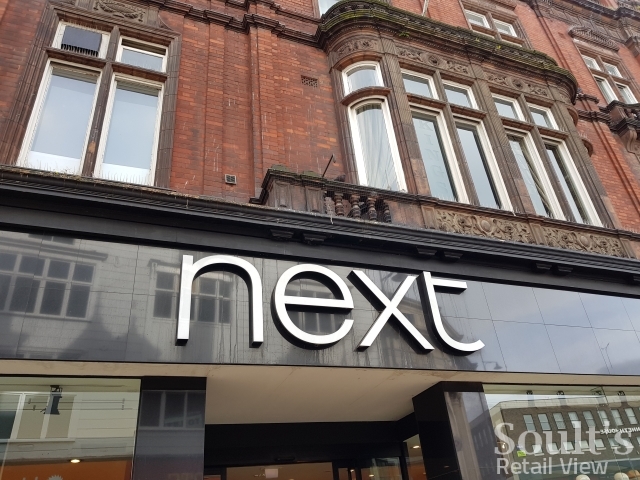
Former Woolworths in Darlington – now Next (25 Aug 2017)
And let’s not forget other important investments in recent years, such as Next taking the large ex-Woolworths space, or, in 2014, Peacocks choosing to return to Darlington after a couple of years away.
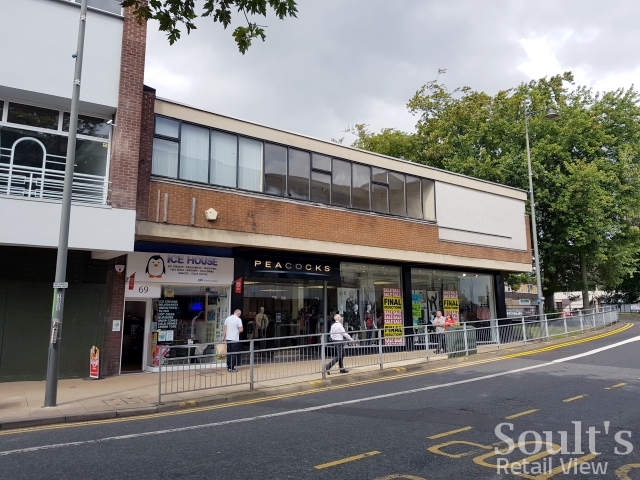
Peacocks in Darlington (25 Aug 2017)
Independent offer

Me in Grange Road, Darlington (25 Aug 2017)
Of course, it’s not just big names that contribute to Darlington’s appeal as a place to shop and visit. One of the town’s great strengths is its independent retail and leisure offer, particularly around Grange Road and Coniscliffe Road. I took time to explore this area when I visited Darlington most recently – partaking of a Friday afternoon pint at Number Twenty 2 – and this independent cluster is a fantastic asset to the town, full of colour, interest and distinctiveness.
So, if these are all Darlington’s strengths, what do we need to do to retain and enhance the town’s appeal?
Attractiveness
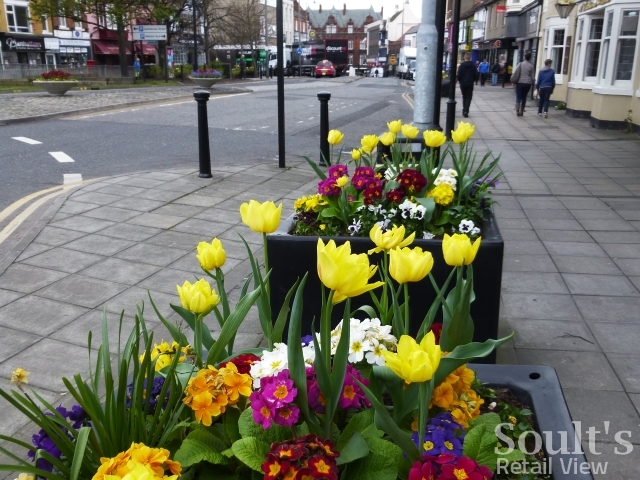
Spring flowers in Bondgate, Darlington (12 Apr 2017)
As I told the Northern Echo recently, one of my main areas of concern is making sure that basic housekeeping in the town centre is maintained. In other words, addressing all those factors – such as street cleaning, flowers, and tourist information – that help to make a place feel safe, welcoming, attractive and vibrant.
Indeed, recent research by the respected Institute of Place Management (IPM) at Manchester Metropolitan University found that a retail centre’s visual appearance was the second most important factor influencing the vitality of a high street – ahead of even the retail mix. As Stockton has found, maintaining a visually attractive town centre not only encourages shoppers to visit and return, but also makes the prospect of businesses investing more likely.
This before/after pic by @soult has had nearly 1,000 likes on LinkedIn! It shows how #Stockton is changing for the better #GBHighSt pic.twitter.com/60opgZGCqJ
— Shopping in Stockton (@stocktonshops) October 24, 2016
Of course, I recognise that all local authorities, including Darlington Borough Council, are having to make unwanted cuts in many areas of operation, including in how their town centres are maintained and managed.
And in Darlington, such pressures are compounded by the recent closure of the private-sector Business Improvement District (BID), Distinct Darlington, which had operated since 2012, but which rate-paying businesses chose not to renew.
Nevertheless, it’s a fact that the BID’s demise has left a big gap that no-one else has yet filled. Darlington is certainly worse off now that things like the food festival, Christmas lights, hanging baskets, street rangers and social media marketing are no more, and risks being left behind by other centres, such as Stockton, that are continuing to invest heavily in these areas.
Marketing
So, what can Darlington do? One thing I’d like to see more of is the town’s retail, leisure and tourist offer being properly championed and marketed. With the BID gone, it’s hard to find a definitive source, on the web or social media, where a prospective visitor to Darlington can find all the information they need in one place.
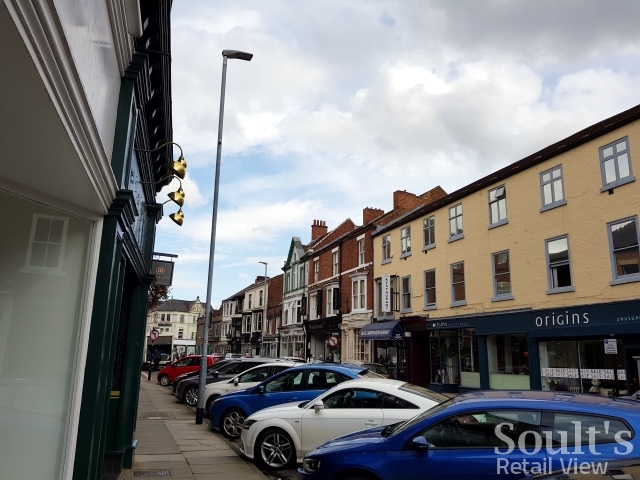
The independent retail and leisure hub of Grange Road, Darlington (25 Aug 2017)
The council’s impending “Visitor Economy Strategy” may well address this, but there’s also scope for the town’s fantastic independent businesses to take matters into their own hands, perhaps by setting up an ‘Independent Darlington’ Facebook presence – similar to Our Whitley Bay – to showcase the quality and breadth of the indie offer.
https://twitter.com/OurWhitleyBay/status/866009445108654080
Events
Besides ensuring that the town centre is clean and attractive, the local authority needs to do what it can to plug the other gaps left by the BID, and to come up with new initiatives that drive footfall, such as specialist markets and other events.
In Middlesbrough, for instance, the popular Orange Pip Market – combining street food, music, arts and crafts – continues to break its own attendance records.
https://twitter.com/OrangePipMarket/status/901368624123858944
Evening economy
In the IPM work that I mentioned, the number-one factor affecting a town centre’s performance was “ensuring the centre is open when the catchment needs it”.
Nowhere has delivered this better than Newcastle, where the free parking and late-night opening of the city’s ‘Alive After Five’ initiative, driven by the Newcastle NE1 BID, has, as of November last year, generated £708m for the local economy and 11.6 million extra visits.
More than £700 million comes into city centre economy over 6 years of @NewcastleNE1 'Alive After 5' initiative. @NE1BID pic.twitter.com/txI2IEnzTr
— Jon Harle (@JonHarle1) November 15, 2016
Darlington, in contrast, remains a town centre that largely shuts down at 6pm, but its attractive bars and restaurants do provide a starting point for growing the evening economy.
Parking
On the issue of parking, there’s room for action here too. Of course, free parking is no panacea, and the blanket abolition of charges seen in Northumberland makes no sense if free all-day shopper spaces are then filled up by commuters. Nevertheless, there’s room for free parking where it allows more effective use to be made of the available spaces, and removes a barrier that can prevent people visiting the town centre.
Stockton, for example, has invested in affordable parking, with the first hour free in all the council’s short-stay car parks. Similarly, many Middlesbrough car parks offer a free two-hour parking option.
With over 2,000 car parking spaces in Stockton town centre it's even easier to visit the Great British High Street Awards' Rising Star! pic.twitter.com/hRRqJ5RE7N
— Stockton BID (@StocktonBID) May 6, 2017
I understand that Darlington, in contrast, currently offers no free parking at all. So, it would make sense to look at the town’s parking provision, and to introduce initiatives such as ‘free after 3’ if there are quiet times when car park spaces are currently underused.
Conclusion

High Row in Darlington (25 Aug 2017)
One thing I’ve found from my many travels is that there are plenty of pretty charmless retail centres out there. However, “charmless” certainly isn’t a word you can use to describe Darlington. It has oodles of character, a buzzing independent scene, and, even with recent closures, a strong retail offer for a town of its size.
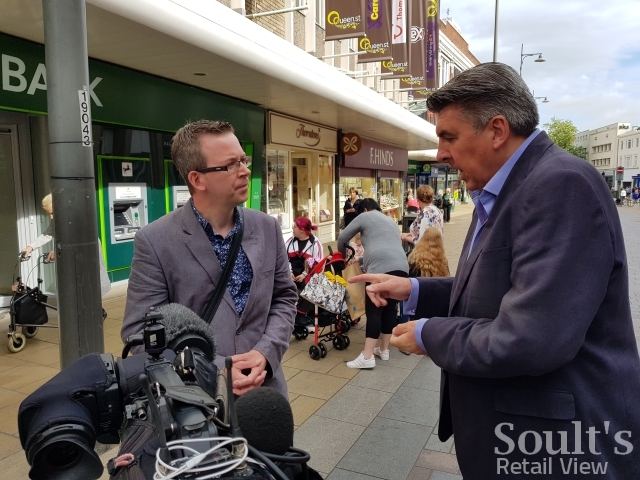
Filming with the BBC’s Ian Reeve in Darlington (25 Aug 2017)
In my view then, the key to Darlington town centre’s future success is to cherish, champion and make the most of these many qualities. That’s about making sure the town centre is clean and attractive, hassle-free to visit, open when people want it to be – and a place that everyone has heard great things about.
Interested in working with me? Head over to CannyInsights.com to find out how I help organisations improve their market insight and digital marketing, or subscribe to Soult’s Retail Report for monthly insights into retail developments around the UK.
By supporting Soult’s Retail Report, you are also helping to sustain the informative (and free) blog updates – like this one – that so many in the retail industry find interesting, enjoyable and valuable.


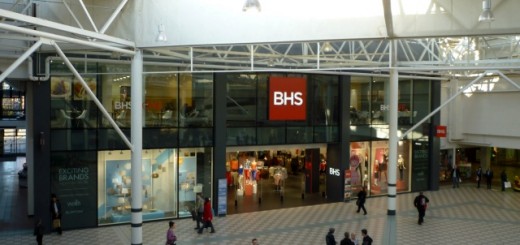

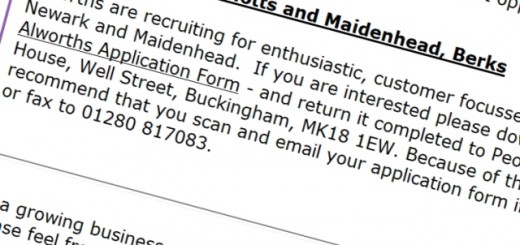





need to discourage the use of self-service tills, these things are evil, they don’t have dinner hours so don’t spend any money in other shops. They save money on wages but who benefits? Any savings they make get trousered by CEOs who live out of town and spend their free time abroad. Just boycott any shop that uses them and so help your community instead of harming it.